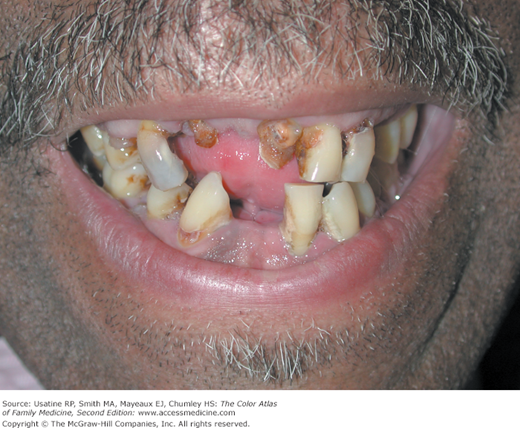Patient Story
A 41-year-old homeless man presents to a clinic on “skid row” with a toothache (Figure 45-1). He has a history of alcoholism and smoking. Many of his teeth are loose and a number of his teeth have fallen out in the past year. He acknowledges that he does not floss or brush his teeth regularly. He has been sober for 60 days now and wants help to get his teeth fixed. He states that no one will hire him with his teeth as they are. He also has pain in a molar and wants something for the pain until he can see a dentist. On oral examination, you see missing teeth, generalized plaque, and teeth with multiple brown caries.
Introduction
Dental caries is a multifactorial disease that is primarily caused by an interaction between bacteria and fermentable carbohydrates producing acid that has potential to demineralize the tooth surface over time. Host factors, such as the plaque (biofilm) adherence, quality and quantity of saliva, immune system response, use of fluoride, and a diet that is caries-promoting, play a role in the formation of incipient demineralized lesions that progress to dental caries. Caries risk is impacted by factors that may be behavioral, biologic, environmental, lifestyle-related, and physical. Age, diabetes, ethnic origin, gingival recession, smoking, and socioeconomic status are frequently associated with high caries prevalence.1
Epidemiology
- Many adults (e.g., 31% of those 20 to 34 years of age, 27% of those 35 to 49 years of age, 24% of those 50 to 64 years of age, and 20% of those 65 years of age and older) have untreated dental caries (Figure 45-1).2
- Black and Hispanic adults, younger adults, and those with lower incomes and less education have more untreated decay.3
- Many older adults suffer from root caries (decay on the roots of their teeth) (Figure 45-2). The percentage of adults with root caries increased with age: 8% of adults 20 to 39 years of age had root decay, compared with 11% of adults 40 to 59 years of age, and 13% of adults 60 years of age and older. The prevalence is greater for black non-Hispanics (20%) and adults below 100% poverty level (19%).4
- More than twice as many current smokers (19%) as nonsmokers (7%) had root caries.4
Etiology and Pathophysiology
- Dental caries result from the activity of dental bacterial plaque, a complex biofilm containing microorganisms that demineralize and proteolyse tooth enamel and dentin through their action on the fermentation of sucrose and other sugars. The main organism is Streptococcus mutans.
- A caries-promoting diet that is high in sugar or acid increases the demineralization process. A cariostatic diet that contains calcium helps buffer the acidity and increase remineralization of the tooth’s enamel surface.
- Low saliva flow and low pH also increase demineralization; the lack of saliva to buffer the acidity from plaque and diet increases caries risk.
- Dental caries progression or reversal depends on the balance between demineralization and remineralization. If caries is untreated and progresses, it eventually destroys enough tooth structure to either have the unsupported tooth fracture, or the caries reaches the tooth’s pulp (nerve tissue) and leads to infection that can progress through the pulp to the tooth’s root apex and surrounding bone.
- Plaque also impacts the gingival tissues; if it is not removed regularly, it may calcify with the minerals in the saliva and form calculus (tartar).





